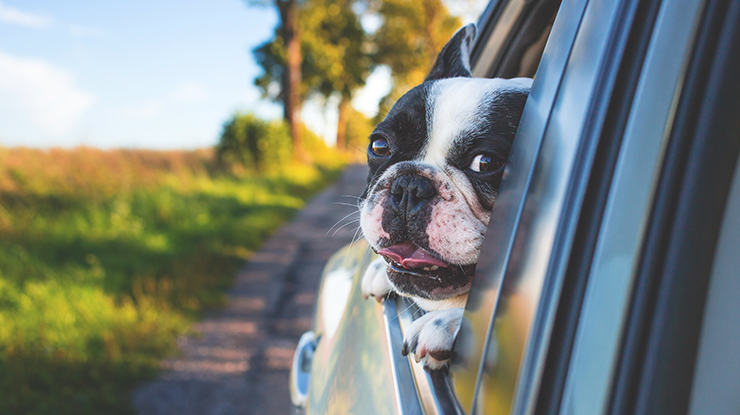
How to Travel With Your Dog
You may be going on vacation, but that doesn't mean that you have to leave your canine companion behind. It's not uncommon for dog owners to leave their dog with a sitter or kennel because they don't think that it's possible to take them along. In reality, there are a number of ways to bring your dog along for the fun.
Whether you're going across the state or on the other side of the world, it's important to plan ahead to avoid any nasty surprises. Traveling with a dog can be tricky. With unique rules and guidelines at hotels or airlines, you have to be prepared for anything. Keep these tips in mind for your next vacation to ensure that everything goes smoothly.
Planning the Trip
Having a dog along with you on your next adventure is a lot like having a child. You should plan every aspect of your trip to ensure that your furry travel buddy is comfortable at all times. Look at specific routes, hotels, and adventure spots, and then create an itinerary.
With this itinerary, you can check out the rules and regulations of your destination. While your dog may be a behaved angel, not everyone is going to welcome him with open arms. Many hotels and airlines have strict rules that forbid canine guests. Others have safety standards that you must comply with.

International Travel
Many countries have individual rules governing canine visitors. These guidelines are in place to prevent the spread of diseases throughout the country. Even Hawaii has strict rules for animals that enter the state.
It's important that you research the laws of the location you will both be visiting. It's not uncommon to see required tests, certifications, or procedures. For example, many countries in Europe require mandatory microchipping and certification signed by a USDA vet. Some destinations also have lengthy tests or quarantine requirements. The UK requires dogs to take special tests a full four months before arrival.
Accommodations
While some hotels and resorts are dog-friendly, there are many that don't allow pets anywhere on the premises. Call the hotel prior to making a reservation to ensure that your pooch is welcomed with open arms. Those that do allow pets often have special rooms and extra perks to make your dog more comfortable.
Introducing Your Dog to a Crate
Crates should be used anytime you're traveling. They act as a way to keep your dog contained and easy to transport. Long before you travel, you need to introduce the crate to your dog and make him comfortable. Crates aren't scary to dogs unless you inject some type of fear or anxiety, so you need to be strategic to get your dog comfortable with getting in and staying put.
Make Sure it Fits
The first thing you should do is make sure that your dog fits in the crate. You should never force a dog into a crate that's too small. It's not uncommon for owners to purchase crates online without doing proper research, which can lead to discomfort if the crate turns out to be a poor fit.
Your pooch should have plenty of room to move around in the crate. It should be long enough to let him turn around in a circle. He should also be free to sit down, lay down to rest, or stand up as needed.
Make it Comfortable
A comfortable crate will compel your canine companion to get in and get cozy. This can be done by removing any unnecessary objects and introducing something your dog loves. Make sure that there's nothing that could harm him, such as leashes that could get wrapped around his neck.
Invest in a small water tray. They can be attached to the walls of the crate and provide your dog with enough water to stay hydrated on the go. You can also use a comforting toy, sleeping blanket, or article of clothing.

Getting Your Dog Used to Travel
Before you bring your dog to the crate, let them get some exercise. Burn away all of their energy so that they have nothing left for feelings of anxiety. If they're tired, they're more than likely to enter the crate and get some rest.
The worst thing you can do during this first contact is to make it feel like a prison. Doing so will make your dog anxious. Instead, be confident and positive. Be happy when closing the door behind him and walk away with good energy to make him feel at ease. Leave your pup in the crate for about 15 minutes before checking in on him. Doing this will make him comfortable with being alone while also letting your dog know that you'll always come back for him.
Bringing Your Dog In a Car
A crate should be used when you're riding in a car. While it is tempting to let your dog roam free and stick his head out of the window, doing so is dangerous. Not only would he be a distraction, but he is exposed to danger if you need to stop suddenly.
If your dog is already used to being in a crate, getting into the car should be no problem. Secure the crate in place prior to leaving. You should also allow your dog to expend his energy and make sure he’s fed before leaving. However, avoid feeding him too much. A full stomach can lead to motion sickness. You should also avoid feeding him while in motion.

Bringing Your Dog on a Plane
Once you've taken care of the airline and destination guidelines concerning dogs, it's time to prepare your pup for travel. If your dog is under 25 pounds, you have to decide if he will fly in cargo or with you in the cabin. Dogs over 25 pounds automatically go into cargo on most flights.
Either way, you'll need your handy crate to make air travel easy. You should avoid feeding your dog for six hours before the flight. A full stomach of food or water isn't recommended, especially for long flights. Let your dog use the bathroom prior to departing, and make sure to supply enough water in the crate to keep him hydrated.
When you separate, continue to use confident voice and body language. Don’t project worry, concern, or anxiety in your actions and mannerisms, or else your dog will likely pick up on those emotions and react negatively himself. If needed, supply them him an item of comfort. One thing you should avoid is medications. Many dog owners rely on sleeping or calming medications to ease travel stress, but instead of using medications, try to use your skills as an owner to keep him comfortable without the assistance of drugs.
Bringing your dog with you on a vacation can be a very fun and rewarding experience. Your dog is part of your family, so why not give him the experience of a lifetime, too? With these tips in mind, you can plan your trip accordingly. Proper preparation will ensure that your trip is worry-free and full of fond memories.
About the Author:
Jack Thomson is the co-founder of Dailydogstuff, a practical resource for training, caring, and feeding dogs of/in all stages. Jack has been a dog owner for more than eight years, and continues to explore all possible ways to spend time with his dog.











